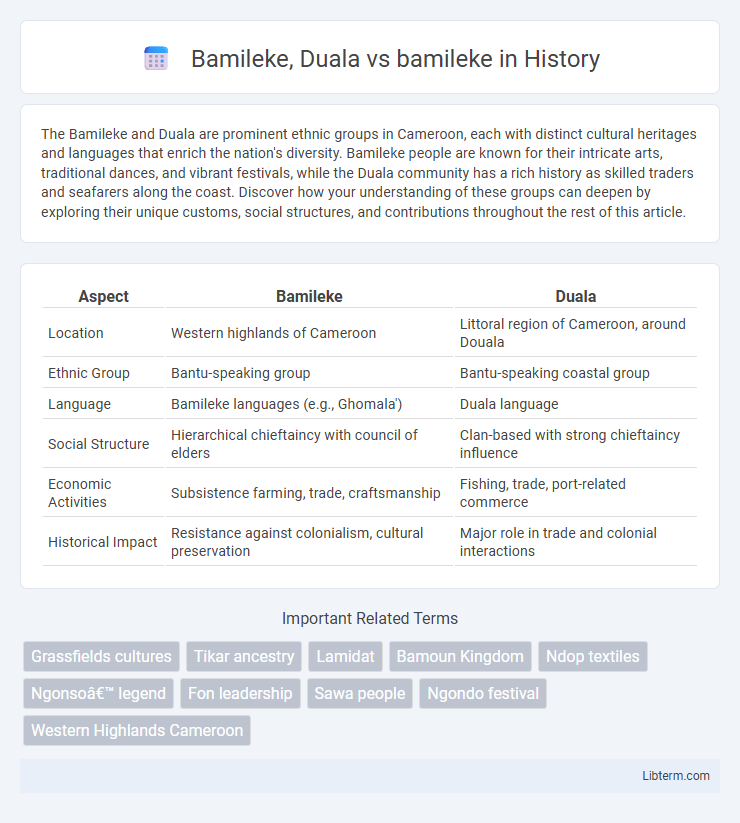The Bamileke and Duala are prominent ethnic groups in Cameroon, each with distinct cultural heritages and languages that enrich the nation's diversity. Bamileke people are known for their intricate arts, traditional dances, and vibrant festivals, while the Duala community has a rich history as skilled traders and seafarers along the coast. Discover how your understanding of these groups can deepen by exploring their unique customs, social structures, and contributions throughout the rest of this article.
Table of Comparison
| Aspect | Bamileke | Duala |
|---|---|---|
| Location | Western highlands of Cameroon | Littoral region of Cameroon, around Douala |
| Ethnic Group | Bantu-speaking group | Bantu-speaking coastal group |
| Language | Bamileke languages (e.g., Ghomala') | Duala language |
| Social Structure | Hierarchical chieftaincy with council of elders | Clan-based with strong chieftaincy influence |
| Economic Activities | Subsistence farming, trade, craftsmanship | Fishing, trade, port-related commerce |
| Historical Impact | Resistance against colonialism, cultural preservation | Major role in trade and colonial interactions |
Introduction to Bamileke and Duala Ethnic Groups
The Bamileke and Duala are prominent ethnic groups in Cameroon, each with distinct cultural identities and historical backgrounds. The Bamileke, predominantly found in the Western highlands, are known for their vibrant arts, elaborate traditional ceremonies, and strong agricultural economy. The Duala inhabit the coastal regions around Douala, excelling in trade and commerce with a rich heritage linked to early European contact and port city development.
Historical Origins of the Bamileke
The Bamileke people originate from the western highlands of Cameroon, with historical roots tracing back to the Tikar kingdom in the Adamawa region, reflecting a migration pattern influenced by regional conflicts and economic opportunities. The Duala, in contrast, are coastal dwellers along the Wouri River estuary, historically recognized for their strategic role in trade between the interior and European traders since the 15th century. Understanding the Bamileke's inland origin highlights their strong agricultural traditions and centralized chieftaincy systems, while the Duala's coastal settlement underscores their maritime trade and interaction with colonial powers.
The Duala People: An Overview
The Duala people, indigenous to the coastal regions of Cameroon, are renowned for their vibrant trading history and significant influence in the economic development of the region. Unlike the Bamileke, who are predominantly highland agriculturalists with a strong emphasis on artisanal crafts and traditional chiefdoms, the Duala have historically thrived as maritime traders and cultural mediators between European colonizers and inland groups. Their unique linguistic heritage, rooted in the Duala language, reflects their central role in fostering commercial and cultural exchanges along the Cameroonian coast.
Language Differences: Bamileke vs Duala
Bamileke language belongs to the Grassfields Bantu family and features a variety of dialects, primarily spoken in the Western Highlands of Cameroon, while Duala belongs to the Coastal Bantu subgroup and is predominantly used in the Littoral region. Bamileke languages exhibit tonal variations and complex noun class systems distinct from Duala's simpler phonology and lexical structure. These linguistic differences reflect the diverse cultural identities and historical interactions within the Cameroonian Bantu-speaking populations.
Social Structure and Organization
The Bamileke and Duala ethnic groups in Cameroon exhibit distinct social structures and organization reflecting their cultural identities. Bamileke society is characterized by a complex lineage-based hierarchy with paramount chiefs overseeing clans and sub-clans, emphasizing strong kinship ties and communal land ownership. In contrast, the Duala social organization revolves around influential coastal chieftaincies and trading families, where leadership is often hereditary and heavily involved in commerce and diplomacy.
Cultural Practices and Traditions
The Bamileke and Duala peoples of Cameroon maintain distinct cultural practices and traditions rooted in their ethnic identities. Bamileke culture emphasizes elaborate initiation rites, intricate beadwork, and vibrant pottery art symbolizing their strong ancestral connections and communal values. Duala traditions focus on fishing-based livelihoods, elaborate festivals featuring traditional dance and music, and the use of the Douala language, reflecting their coastal heritage and trade history.
Economic Activities and Livelihoods
The Bamileke primarily engage in agriculture, cultivating crops like coffee, cocoa, and peanuts, supplemented by artisanal craftwork and local trade to sustain their livelihoods. In contrast, the Duala, residing along the Cameroonian coast, focus on fishing, trading, and port-related commerce, capitalizing on their strategic location for economic activities. Both groups maintain vibrant economic systems deeply rooted in their environmental contexts and cultural traditions.
Political Influence and Leadership
The Bamileke people hold substantial political influence in Cameroon, with many prominent leaders emerging from their community, particularly in economic sectors and national politics. In contrast, the Duala group, primarily coastal traders, traditionally exert significant control over commerce and port administration, impacting regional political dynamics. Both ethnic groups contribute uniquely to Cameroon's leadership landscape, shaping policies through their distinctive historical roles and socio-economic strengths.
Interactions and Relationships Between Bamileke and Duala
The Bamileke and Duala communities, both prominent ethnic groups in Cameroon, have historically engaged in complex social and economic interactions marked by trade and cultural exchange. While the Bamileke are primarily inland agriculturalists, the Duala have traditionally been coastal traders, facilitating commerce between inland populations and European markets. These relationships have fostered interdependence, with the Bamileke supplying agricultural goods and the Duala providing access to maritime trade networks, shaping the socio-economic landscape of the region.
Modern Challenges and Future Prospects
The Bamileke and Duala peoples face modern challenges such as economic marginalization, cultural erosion, and political underrepresentation in Cameroon's rapidly changing landscape. Both groups are actively engaging in cultural preservation efforts and leveraging entrepreneurship and education to improve socioeconomic status. Future prospects hinge on increased political inclusion, sustainable development projects, and the promotion of cultural heritage to ensure resilience and growth.
Bamileke, Duala Infographic

 libterm.com
libterm.com